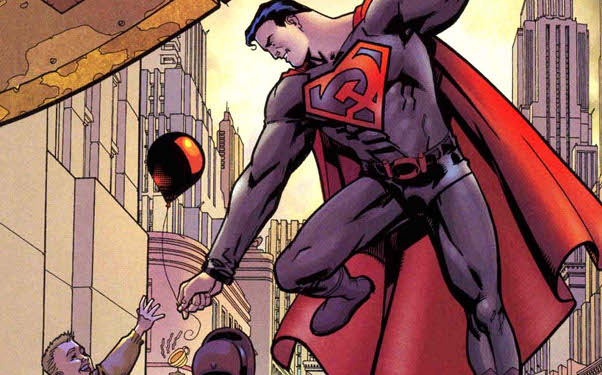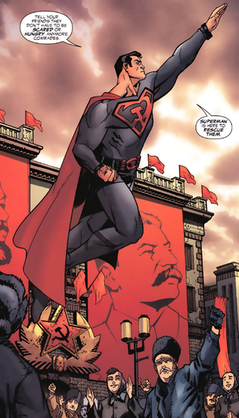Superman: Red Son
 |
| No "in Soviet Russia" jokes... I promise. |
Writer: Mark
Millar
Artists: Dave
Johnson, Killian Plunkett, Andrew Robinson
Collects: Superman: Red Son #1-3
Background
Information:
This is usually where I write what you need to know before coming
into the book. This time, I want to talk about the perspective I took to
reading Red Son, and how my
experiences prepared me to read this collection.
I lived about two years in the Baltic nations; the countries
of Latvia, Estonia and Lithuania- all formerly under control of the Soviet
Union. I met people who had very mixed views of the communist era. Coming from
a largely capitalist culture, I went to the Baltics thinking that all of the
locals would view soviet occupation the same way I do; a terrible regime that
destroyed lives for the sake of the state. And to be fair, plenty did. I heard
the stories of brainwashing in ways that some erroneously only associate with
religion and saw the graves of those killed by the KGB. I also met plenty- some
not much older than I- who looked back on the communist era with a sort of
fondness- a time when things were simpler. It was surprising to me that people
who experienced the exact same government could emerge with such dramatically
different views on it.
Review:
And it’s that experience that really coloured my perception
of Red Son; more than just a great
superhero story, Red Son is a great
look at the shades of grey that surrounded both the USSR and the USA during the
cold war. It’s also, surprisingly, one of the books that seems to get Superman better than anything else
I’ve read.
 |
| He's Russian to help people out... hyuk, hyuk, hyuk! |
This story takes one thing central to Superman and turns it
on its head; namely, Superman’s American heritage. Here, Superman was raised on
a farm collective in the Ukraine. Growing up as a communist, Superman spends
years working for Stalin before taking over as the new president of the USSR.
The role sees him make some pretty disturbing decisions, such as reprogramming
rebels into “robots” and ruling with a more or less iron fist.
Writer Mark Millar is also known for writing Marvel’s Civil War, which also dealt with themes
of moral ambiguity. Throughout Civil War,
it was kinda hard to tell who the good guys and who the bad guys were. Millar
amps that up in Red Son. Sure,
Superman has his enemy in Lex Luthor, but it’s near impossible to say who you
would support. They both come across as people with heroic intentions, but the
means by which they achieve these intentions are often so disturbing. It’s a
pretty amazing understanding of how the USA and USSR conducted itself- sure, America
was right to reject a system that treated its own people more poorly than ever,
but did that justify McCarthyism? At the same time, yes, Luthor is right to
fight a Superman who effectively brainwashes his enemies, but the extents to
which he goes to do so are hard to accept.
Superman fans who constantly get annoyed by Batman fans when
they refer to The Dark Knight Rises
as proof why Batman would always beat Superman need look no further than Red Son. This is not the best part of
the book, by far (that award goes to the way that Luthor eventually stops
Superman- but I shan’t spoil that), but it’s worth mention that even with prep
time, Batman is not guaranteed a victory. Red sun lamps, ultimately, aren’t
enough to keep Superman down when there are plenty of people around who would
leap to help the Man of Steel- as shown in the middle chapter of this
collection.
The best thing about this collection, though, is that Millar
shows that he understands what Superman is meant to be. It’s ironic that in the
last decade, the book to be the most representative of what it means to be
Superman is one where Superman is the opposite of what he normally is. Even
without the mark of ‘murica, Millar seems to fully understand Superman’s
greatest struggles; his otherness to people that he considers his own, his
constraining ties to his adopted nation, his compulsion to save everyone even
though he can’t- and possibly shouldn’t. These are all things that I feel make
an excellent Superman story- it’s the overcoming of these obstacles that
inspires hope; not fights against Zod or flying so fast that you turn back
time.
 |
| He's a powerful man, and that's Putin it lightly. Missing those "In Soviet Russia..." jokes yet? |
There’s a separate artist for each issue of Red Son. Normally, that would be a bad
thing, but here, it looks great- a clear indicator that each issue is a different
stage of Superman’s life. What’s more, each issue makes Russia look like Russia- the architecture (not
just the Kremlin) and character costumes (which thankfully don’t limit
themselves to furry hats and headscalves) look very soviet. Even Batman’s equipment
looks very soviet-era; less about form, more about function. Then there are the
small things (the eagle design on Wonder Womans chest, for example, that
resembles the two-headed bird of the Russian coat of arms) that help to
solidify that you aren’t just seeing these characters visit a different
location; these are Russian heroes in every sense of the word.
There’s really nothing bad I can say about Red Son which is why it gets a perfect
five out of five marks of ‘murica.
*****
+ Amazing job of moral ambiguity.
+ Understands Superman better than any other book from the
last ten years.
+ Superman beats Batman
+ Art gives that real “soviet” feel
Alternate Option: All-Star Superman
It’s still the second-best Superman that I’ve read, but
nowhere near the worst.






